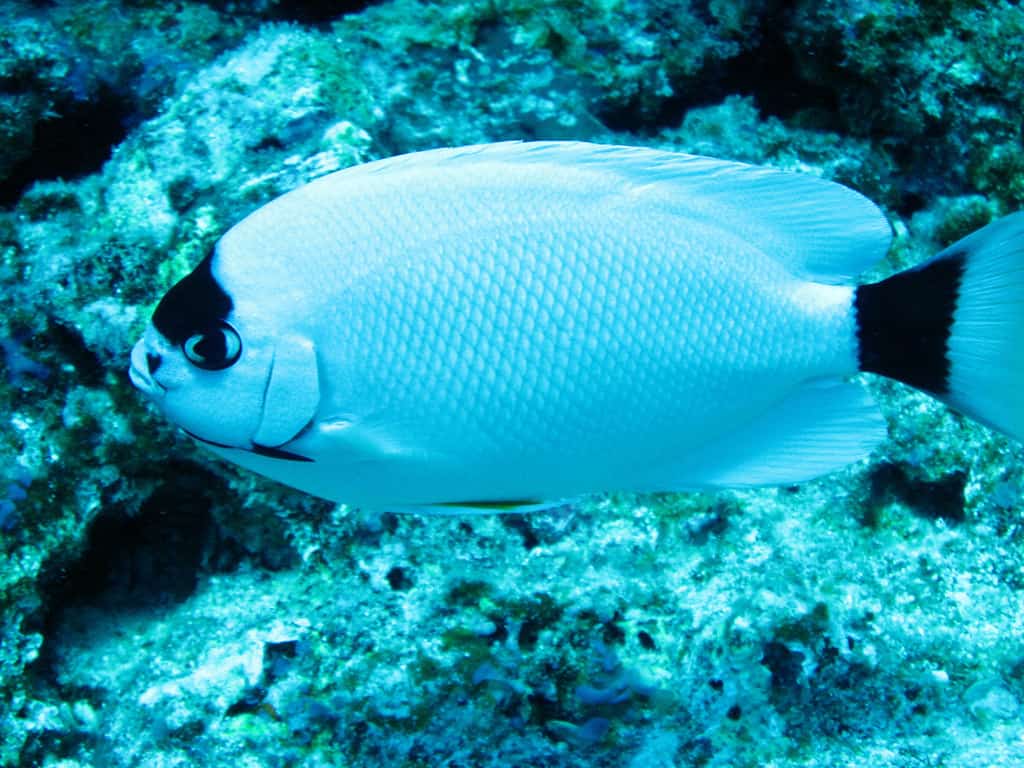Masked Angelfish
G. personatus
All masked angelfish are female until sometime after sexual maturity, at which point some become male.
Advertisement
Masked Angelfish Scientific Classification
- Kingdom
- Animalia
- Phylum
- Chordata
- Class
- Actinopterygii
- Order
- Perciformes
- Family
- Pomacanthidae
- Genus
- Genicanthus
- Scientific Name
- G. personatus
Read our Complete Guide to Classification of Animals.
Masked Angelfish Conservation Status
Masked Angelfish Facts
- Prey
- algae, plankton, roe (fish eggs)
- Fun Fact
- All masked angelfish are female until sometime after sexual maturity, at which point some become male.
- Biggest Threat
- None
- Most Distinctive Feature
- Black “mask” around the eyes (females only)
- Distinctive Feature
- Their bright white color
- Diet for this Fish
- Omnivore
- Common Name
- Masked Angelfish
- Number Of Species
- 1
View all of the Masked Angelfish images!
The masked angelfish is a type of marine fish.
It is a ray-finned fish, endemic to the coastal reefs around Hawaii, their only location. All masked angelfish are born female, as is common in several other fish species. Once masked angelfish reach a certain age and size, the more dominant fish will become male and some of their fins will elongate. They are not common in the aquarium trade, but they are occasionally kept as pets. Breeding attempts in captivity have recently been successful, so their rarity in the hobbyist world may soon change.
5 Masked Angelfish Facts
- Masked angelfish are sequential protogynous hermaphrodites, meaning some change their sex from female to male upon reaching sexual maturity.
- A masked angelfish price can be between $16,000 to $20,000!
- Male masked angelfish are only black on their tails, while female Genicanthus Personatus are only yellow on their bottom fins.
- Because these white angelfish live at such depths, very little is known about the lifecycle of the masked angelfish.
- Rarely can divers catch more than two masked angelfish in a single year and often they can’t catch any.
Classification and Scientific Name
The scientific name for the masked angelfish is Genicanthus personatus. Genicanthus simply refers to their species of angelfish, while personatus means masked. Though there are many species of angelfish, the masked angelfish is among one of the rarer breeds, since they only live in a single location.
Masked Angelfish: Appearance
Adult masked angelfish are predominantly bright white all over their bodies. Juvenile masked angelfish have black over most of their heads, but this color slowly fades and disappears as they age. Eventually, the black portion of the female’s coloring is reduced down to only a small patch or “mask” around their eyes and possibly around their mouths, and a black stripe on their tail. The fins on the bottom of their bodies are yellow to yellow-orange in color and are brighter in male masked angelfish than in females. A male’s mask is also yellowish orange as are all their fins. Male masked angelfish have solid black tails except for the long, thin tips, which are yellow.

Masked angelfish are all born female but some change to male when they reach sexual maturity!
©
Distribution, Population and Habitat
Masked angelfish are found solely in Hawaii. Though they are rarely caught, they are not endangered. They range primarily around the northwest islands of Hawaii, such as Oahu. The preferred swimming depth of a masked angelfish is around 300 feet, a location beyond the limits of most divers. Masked angelfish live among the coral reefs. The masked angelfish was last assessed for The IUCN Red List in 2009 and was at that time listed as Least Concern (LC). The depth at which they live and the availability of their diet combined with the difficulty for humans to reach them, provide the masked angelfish with more protection than many other species. They also have a curved spine near their gills, making them a hard target for predators.
Masked Angelfish: Predators and Prey
Masked angelfish eat zooplankton, green algae, and sometimes the roe of other fish species. They are prey for larger fish species and for marine mammals, but the spiky barbs located on their faces deter many predators from attacking them.
Reproduction and Lifespan
Breeding in captivity has only been achieved within the last decade or so. Though a masked angelfish that is well cared for can live up to six years, the average lifespan for a captive masked angelfish is only about two years. Females release eggs which are then fertilized in the water by the male Genicanthus personatus. The eggs will attach to rocks or coral or other substrate and will be guarded by both of the parents until they hatch.
View all 164 animals that start with MMasked Angelfish FAQs (Frequently Asked Questions)
How much is a masked angelfish?
A masked angelfish sells for up to $20,000. This price is because of their rarity.
How long do masked angelfish get?
Masked angelfish reach a maximum length of about eight to eight and a half inches.
Where can I find masked angelfish?
A Genicanthus personatus can most often be found at depths of 300 feet, off the coast of Oahu, Hawaii.
What do masked angelfish eat?
These omnivorous angelfish eat a specific type of green algae, some kinds of plankton, and the roe of other species of fish.
How long do masked angelfish live?
The lifespan of a masked angelfish is only about two years in captivity, though they may live up to six years.
Thank you for reading! Have some feedback for us? Contact the AZ Animals editorial team.
Sources
- Reefs / Accessed April 29, 2022
- Wikipedia / Accessed April 29, 2022
- Tropical Fishkeeping / Accessed April 29, 2022
- Marine Collectors / Accessed April 29, 2022
- Waikiki Aquarium / Accessed April 29, 2022
- Reefland / Accessed April 29, 2022
- Algae Barn / Accessed April 29, 2022
- Reef Builders / Accessed April 29, 2022
- Among The Reef / Accessed April 29, 2022
- Fish Base / Accessed April 29, 2022
- Coral Realm / Accessed April 29, 2022
- Amazing Animals Planet / Accessed April 29, 2022
- Mem Fish / Accessed April 29, 2022


















